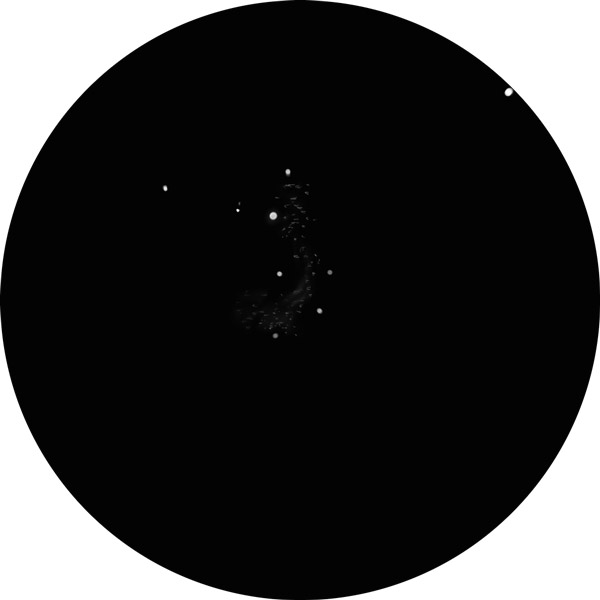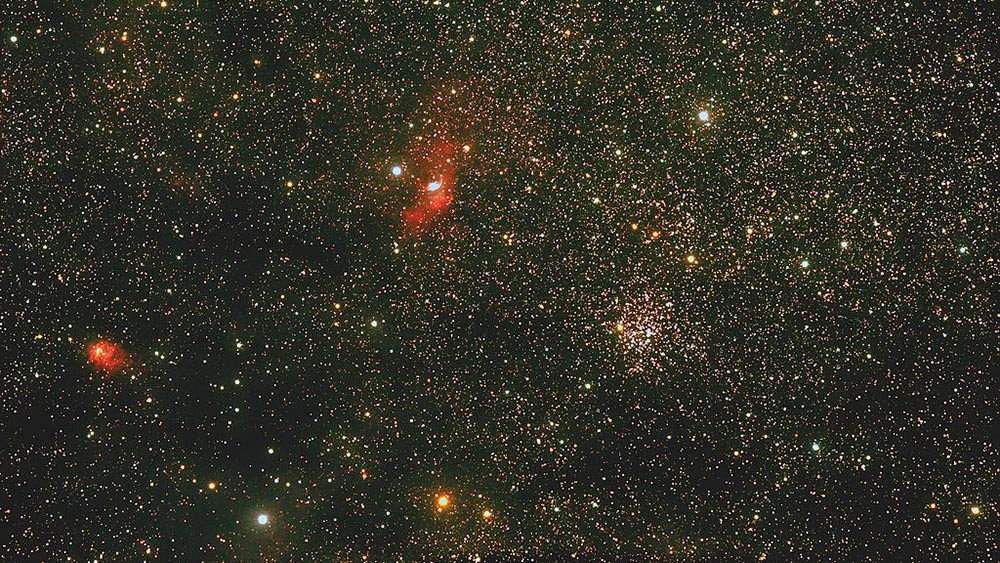Messier 52, also known as the Scorpion Cluster, is an open cluster in the constellation of Cassiopeia. It is best viewed from late fall through winter. One of the most striking features of M52 is its location in the Milky Way galaxy. The cluster is located near the galactic plane, which means that it is surrounded by a rich field of stars and other celestial objects.
M52 is a condensed cluster of mostly faint stars sitting in the Milky Way sea of stars. This makes the object tougher to find. One interesting feature of M52 is the presence of several red giants within the cluster. These stars are in the later stages of their evolution, having exhausted their hydrogen fuel and expanded to many times their original size. Red giants are among the most colorful and visually striking stars in the sky, and their presence in M52 adds to the cluster’s overall beauty and interest.
Historically speaking, the Italian astronomer Giovanni Battista Hodierna discovered the cluster in the mid-17th century, to be later independently rediscovered by the French astronomer Charles Messier in 1774.1
My Observations
| Date | November 1, 2020 |
| Time | 7:47 p.m. |
| Location | Seattle, WA |
| Magnification | 127x |
| Scope | Meade 8″ SCT |
| Eyepiece | 16mm |
| Seeing | Average |
| Transparency | Average |

M52, at least on a moon-filled night, isn’t very bright, and it doesn’t jump out when scanning the sky to find it. There are 4 to 5 prominent stars among a “haze” of dense stars. On the “right” side of the cluster in the eyepiece, it seems this haze curves slightly in and out like a river.
Also observed on October 11, 2021, at 8:25 p.m.
Key Stats
| Constellation | Cassiopeia |
| Best Viewing | Autumn |
| Visual Magnitude | +6.9 |
| Absolute Magnitude | -3.8 |
| Distance from Earth | 4,600 ly |
| Diameter | 20 ly |
| Apparent Size | 15 arcmin |
| Milky Way Location | Perseus-Orion |
| My Viewing Grade | B |
Historical Observations
September 7, 1774, observation by Charles Messier
“Cluster of very small [faint] stars, mingled with nebulosity, which can be seen only with an achromatic telescope. It was when he observed the Comet which appeared in this year that M. Messier saw this cluster, which was close to the comet on the 7th of September 1774; it is below the star d Cassiopeiae: that star was used to determine [the position of] both the cluster of stars & the comet.”
Sources and Notes
Banner photo provided by NASA. Public Domain.
1 esiegel on March 4, 2013. “Esiegel.” ScienceBlogs, https://scienceblogs.com/startswithabang/2013/03/04/messier-monday-a-star-cluster-on-the-bubble-m52.
2Charles Messier Observations: SEDS Messier Database















